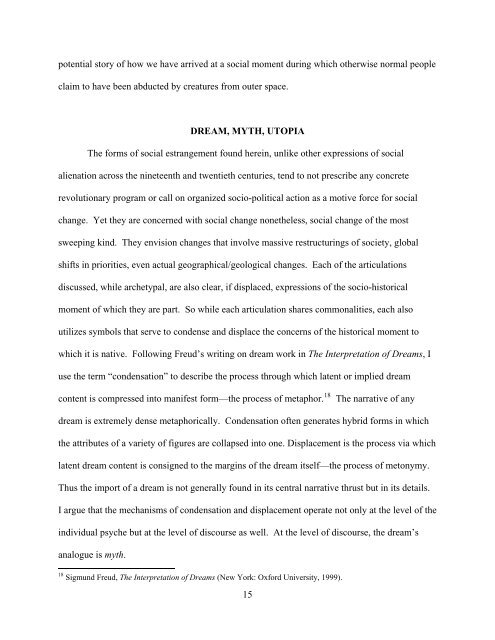A Genealogy of the Extraterrestrial in American Culture
A Genealogy of the Extraterrestrial in American Culture
A Genealogy of the Extraterrestrial in American Culture
Create successful ePaper yourself
Turn your PDF publications into a flip-book with our unique Google optimized e-Paper software.
potential story <strong>of</strong> how we have arrived at a social moment dur<strong>in</strong>g which o<strong>the</strong>rwise normal people<br />
claim to have been abducted by creatures from outer space.<br />
DREAM, MYTH, UTOPIA<br />
The forms <strong>of</strong> social estrangement found here<strong>in</strong>, unlike o<strong>the</strong>r expressions <strong>of</strong> social<br />
alienation across <strong>the</strong> n<strong>in</strong>eteenth and twentieth centuries, tend to not prescribe any concrete<br />
revolutionary program or call on organized socio-political action as a motive force for social<br />
change. Yet <strong>the</strong>y are concerned with social change none<strong>the</strong>less, social change <strong>of</strong> <strong>the</strong> most<br />
sweep<strong>in</strong>g k<strong>in</strong>d. They envision changes that <strong>in</strong>volve massive restructur<strong>in</strong>gs <strong>of</strong> society, global<br />
shifts <strong>in</strong> priorities, even actual geographical/geological changes. Each <strong>of</strong> <strong>the</strong> articulations<br />
discussed, while archetypal, are also clear, if displaced, expressions <strong>of</strong> <strong>the</strong> socio-historical<br />
moment <strong>of</strong> which <strong>the</strong>y are part. So while each articulation shares commonalities, each also<br />
utilizes symbols that serve to condense and displace <strong>the</strong> concerns <strong>of</strong> <strong>the</strong> historical moment to<br />
which it is native. Follow<strong>in</strong>g Freud’s writ<strong>in</strong>g on dream work <strong>in</strong> The Interpretation <strong>of</strong> Dreams, I<br />
use <strong>the</strong> term “condensation” to describe <strong>the</strong> process through which latent or implied dream<br />
content is compressed <strong>in</strong>to manifest form—<strong>the</strong> process <strong>of</strong> metaphor. 18<br />
The narrative <strong>of</strong> any<br />
dream is extremely dense metaphorically. Condensation <strong>of</strong>ten generates hybrid forms <strong>in</strong> which<br />
<strong>the</strong> attributes <strong>of</strong> a variety <strong>of</strong> figures are collapsed <strong>in</strong>to one. Displacement is <strong>the</strong> process via which<br />
latent dream content is consigned to <strong>the</strong> marg<strong>in</strong>s <strong>of</strong> <strong>the</strong> dream itself—<strong>the</strong> process <strong>of</strong> metonymy.<br />
Thus <strong>the</strong> import <strong>of</strong> a dream is not generally found <strong>in</strong> its central narrative thrust but <strong>in</strong> its details.<br />
I argue that <strong>the</strong> mechanisms <strong>of</strong> condensation and displacement operate not only at <strong>the</strong> level <strong>of</strong> <strong>the</strong><br />
<strong>in</strong>dividual psyche but at <strong>the</strong> level <strong>of</strong> discourse as well. At <strong>the</strong> level <strong>of</strong> discourse, <strong>the</strong> dream’s<br />
analogue is myth.<br />
18 Sigmund Freud, The Interpretation <strong>of</strong> Dreams (New York: Oxford University, 1999).<br />
15















